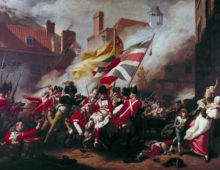Tagged with Working conditions
Resource : Banner from the “Peterloo Massacre”
On the 16th August 1819, a huge crowd of people gathered in St Peter’s Field, Manchester to hear Henry ‘Orator’ Hunt and other noted radical speakers calling for parliamentary reform. At least 17 people would die of injuries received on the day, and around 700 suffered serious wounds at the hands of local armed forces. There was a popular outcry, and the radical press named the incident the ‘Peterloo Massacre’, a mocking reference to the Battle of Waterloo.
Resource : Red Flag
Today the red flag has, predominantly, become a symbol of socialism and communism. Its European origins date back to the Middle Ages, when a red streamer flying from the mast of a warship signalled a willingness to fight to the death, with no surrender. But its radical political roots lie firmly in the Age of Revolution.
Resource : The factory child’s trouble – sampler
This is a sampler that records the sufferings of a child, working in one of the many textile mills in Salford (Greater Manchester). It was sewn by Elizabeth Hodgates who was 12 years old in 1833 and reminds us of the terrible working conditions for children, women and men during the industrial revolution.
Resource : A peep at the gas lights in Pall Mall
Before the 1800s, most homes, workplaces and streets were lit by candles, oil lamps or rushlights (rush plants dried and dipped in grease or fat). But these gave off a very dim light and could be smoky. In 1792, the Scottish engineer and inventor William Murdoch (1754-1839) made an extraordinary discovery which would transform not only lighting, but heating, cooking and all sorts of other activity and industry. Experimenting in his back garden in Cornwall, he found a way to produce gas, by heating coal in a closed container and collecting and cleaning the smoke. He piped the gas into his house, made holes in the pipes and lit the gas there. This produced a light much brighter and safer than from candles or oil lamps.
Resource : View of New Lanark by John Winning
Throughout the 1800s Britain became a busy industrial nation. People migrated in increasing numbers from the countryside to towns and cities to work in new factories and mills. Working conditions were poor and dangerous, injuries from machinery were common and workers – including children as young as six – worked long hours. Overcrowding, limited diets and polluted water led to widespread disease and early death. New Lanark, a village on the River Clyde near Glasgow, was a revolutionary industrial and housing complex, combining a cotton mill with purpose-built housing, education and social care for its workers and their families. The ideas put into practice here marked the beginning of cooperative socialism.
Resource : The life and adventures of Michael Armstrong, the factory boy by Frances Trollope
This illustrated novel by Frances Trollope (1779-1863) was published in monthly parts in 1840, costing one shilling apiece. It tells a fictional story of Michael Armstrong, based on the real-life hardships, exploitation and suffering of children in the workplaces of the Industrial Revolution. It was the first novel about industrial life in Britain and made an important contribution to the campaign to reform conditions for workers – especially children.
Resource : Tolpuddle Martyrs Sculpture
In 1834, six farm workers were arrested and transported to Australia as a result of banding together to improve the miserable wages of farm labourers. The maltreatment of the ‘Tolpuddle Martyrs’, as they became known, helped pave the way for the creation of trade unions and the protection of employees’ rights.
Resource : The Colours by The Men They Couldn’t Hang
This song tells the story of the Nore mutiny in 1797 and the execution of its ‘chief mutineer’ Richard Parker. It illustrates the British government’s fear of protest and potential uprising and the harsh punishments inflicted on those suspected of causing unrest.
Resource : French revolution
The fevered fight for liberté, egalité, and fraternité in France, bringing with it a spate of violent and bloody wars across Europe and sending shockwaves of fear through the British establishment.
Resource : Steam Whistle
The steam engine was one of the most important technologies of the industrial revolution. But it could be dangerous. The invention of the steam whistle made steam power much safer, saving countless lives as steam technology developed and grew through the 1800s.


